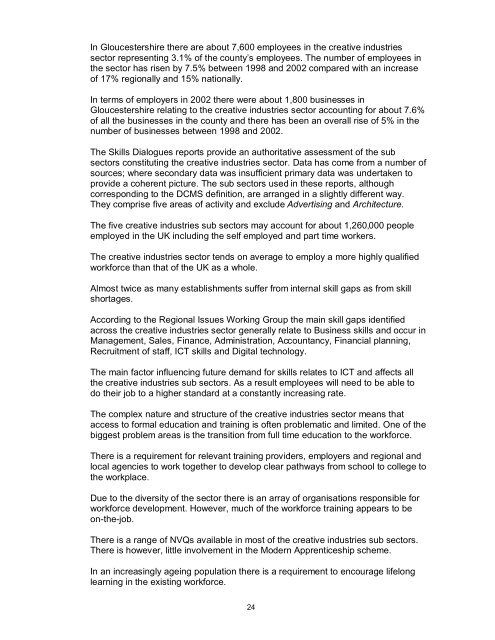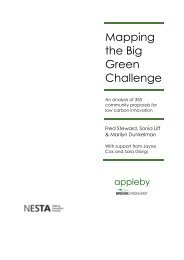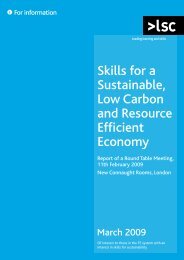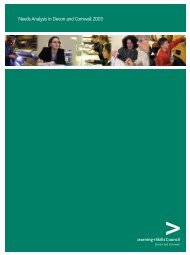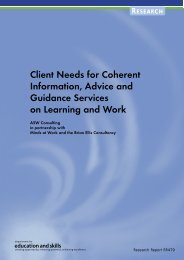An Introduction to the Creative Industries Sector - The Skills ...
An Introduction to the Creative Industries Sector - The Skills ...
An Introduction to the Creative Industries Sector - The Skills ...
You also want an ePaper? Increase the reach of your titles
YUMPU automatically turns print PDFs into web optimized ePapers that Google loves.
In Gloucestershire <strong>the</strong>re are about 7,600 employees in <strong>the</strong> creative industriessec<strong>to</strong>r representing 3.1% of <strong>the</strong> county’s employees. <strong>The</strong> number of employees in<strong>the</strong> sec<strong>to</strong>r has risen by 7.5% between 1998 and 2002 compared with an increaseof 17% regionally and 15% nationally.In terms of employers in 2002 <strong>the</strong>re were about 1,800 businesses inGloucestershire relating <strong>to</strong> <strong>the</strong> creative industries sec<strong>to</strong>r accounting for about 7.6%of all <strong>the</strong> businesses in <strong>the</strong> county and <strong>the</strong>re has been an overall rise of 5% in <strong>the</strong>number of businesses between 1998 and 2002.<strong>The</strong> <strong>Skills</strong> Dialogues reports provide an authoritative assessment of <strong>the</strong> subsec<strong>to</strong>rs constituting <strong>the</strong> creative industries sec<strong>to</strong>r. Data has come from a number ofsources; where secondary data was insufficient primary data was undertaken <strong>to</strong>provide a coherent picture. <strong>The</strong> sub sec<strong>to</strong>rs used in <strong>the</strong>se reports, althoughcorresponding <strong>to</strong> <strong>the</strong> DCMS definition, are arranged in a slightly different way.<strong>The</strong>y comprise five areas of activity and exclude Advertising and Architecture.<strong>The</strong> five creative industries sub sec<strong>to</strong>rs may account for about 1,260,000 peopleemployed in <strong>the</strong> UK including <strong>the</strong> self employed and part time workers.<strong>The</strong> creative industries sec<strong>to</strong>r tends on average <strong>to</strong> employ a more highly qualifiedworkforce than that of <strong>the</strong> UK as a whole.Almost twice as many establishments suffer from internal skill gaps as from skillshortages.According <strong>to</strong> <strong>the</strong> Regional Issues Working Group <strong>the</strong> main skill gaps identifiedacross <strong>the</strong> creative industries sec<strong>to</strong>r generally relate <strong>to</strong> Business skills and occur inManagement, Sales, Finance, Administration, Accountancy, Financial planning,Recruitment of staff, ICT skills and Digital technology.<strong>The</strong> main fac<strong>to</strong>r influencing future demand for skills relates <strong>to</strong> ICT and affects all<strong>the</strong> creative industries sub sec<strong>to</strong>rs. As a result employees will need <strong>to</strong> be able <strong>to</strong>do <strong>the</strong>ir job <strong>to</strong> a higher standard at a constantly increasing rate.<strong>The</strong> complex nature and structure of <strong>the</strong> creative industries sec<strong>to</strong>r means thataccess <strong>to</strong> formal education and training is often problematic and limited. One of <strong>the</strong>biggest problem areas is <strong>the</strong> transition from full time education <strong>to</strong> <strong>the</strong> workforce.<strong>The</strong>re is a requirement for relevant training providers, employers and regional andlocal agencies <strong>to</strong> work <strong>to</strong>ge<strong>the</strong>r <strong>to</strong> develop clear pathways from school <strong>to</strong> college <strong>to</strong><strong>the</strong> workplace.Due <strong>to</strong> <strong>the</strong> diversity of <strong>the</strong> sec<strong>to</strong>r <strong>the</strong>re is an array of organisations responsible forworkforce development. However, much of <strong>the</strong> workforce training appears <strong>to</strong> beon-<strong>the</strong>-job.<strong>The</strong>re is a range of NVQs available in most of <strong>the</strong> creative industries sub sec<strong>to</strong>rs.<strong>The</strong>re is however, little involvement in <strong>the</strong> Modern Apprenticeship scheme.In an increasingly ageing population <strong>the</strong>re is a requirement <strong>to</strong> encourage lifelonglearning in <strong>the</strong> existing workforce.24


